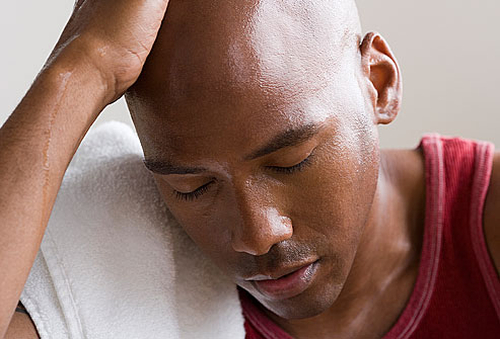The Great Outdoors
Exercising outside during the summer is still an option. Swim in the refreshing waters of a mountain lake or in-line skate on a breezy day. But make sure you take precautions to prevent yourself from getting sunburned and dehydrated.
Use a waterproof sunscreen with an SPF of at least 15 and drink at least 4 ounces of water or fluid-replacement beverage for every 20 minutes of exercise.
If you choose to exercise outside, progress into it slowly, giving your body time to adjust to the heat. Exercise during the cooler parts of the day — first thing in the morning (before 10 a.m.) or after the hot midday hours (after 4 p.m.).
Your heart rate can serve as a good indicator of how your body is tolerating the heat during exercise. On a day of high heat or humidity, your heart will probably beat faster than it usually would doing the same workout. If this happens, it may simply be too hot and humid for you. Slow down or stop what you’re doing and hit the local air-conditioned gym.
Staying Indoors
Most gyms crank up the air-conditioning during the hot months, making it quite comfortable for workouts. However, if the gym doesn’t increase the air, or if you prefer to workout at home, be sure to keep the ventilation going by using a fan or opening the window.
And remember, dehydration can occur even if you’re inside and especially if it becomes warm and humid. The more you sweat, the more water you will need to drink. So you may need to drink more than the recommended amount above. In some cases this amount should be doubled.
If air-conditioning is simply not available, take advantage of the heat by doing yoga or stretching. These activities are most effective when the muscle temperature is high.
Drink Water
Proper hydration is a must. No matter how you choose to exercise or in whatever time of year you choose to do it, your body needs water.
Water accounts for approximately 55 percent to 60 percent of an adult’s body weight. While a loss of 10 percent may pose a significant health risk, a loss of 20 percent can result in death.
Because exercise generates internal body heat, which is released and cooled in the form of sweat (water), prolonged exercise with insufficient fluid replacement can lead to dehydration. Some of the warning signs of dehydration include headaches, muscle cramps, lightheadedness, fatigue, confusion, lethargy and a persistently elevated body temperature. Advanced stages of heat exhaustion can lead to coma and cardiac failure.
And don’t forget your dog. If you take it along with you for exercise, make sure he or she gets enough water. Dogs overheat more easily because they don’t sweat.
The following measures can help you prevent exercise-induced dehydration:
- Drink before, during and after exercise. Don’t rely on your thirst to tell you how much fluid you need.
- Avoid items that contain caffeine (e.g., coffee, soft drinks and tea) or alcohol because these can increase fluid loss.
- Wear light, loose-fitting clothing that allows evaporation and
- If you become overheated, moisten your skin by sponging or spraying it with water to assist in cooling down.
- Avoid the use of saunas, steam rooms and hot tubs immediately following exercise.
- On very hot days, stay indoors or in the shade.
DISCLAIMER: The content on this website is intended for informational and educational purposes only. Consult a doctor for medical advice, treatment or diagnosis.
